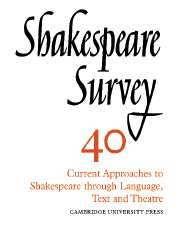Book contents
- Frontmatter
- Reconstructing Shakespeare, or Harlotry in Bardolatry
- Playing Shakespeare
- Take me to your Leda
- Sign Theory and Shakespeare
- Time in Richard III
- New Concepts of Staging A Midsummer Night’s Dream
- Henry V as Working-House of Ideology
- Shakespeare and his Sources: Observations on the Critical History of Julius Caesar
- The Speculative Eye: Problematic Self-Knowledge in Julius Caesar
- Learning by Talking: Conversation in As You Like It
- Measure for Measure: Mirror for Mirror
- Allegory and Irony in Othello
- Cruelty, King Lear and the South African Land Act 1913
- The Rationale of Current Bibliographical Methods: Printing House Studies, Computer-Aided Compositor Studies, and the Use of Statistical Methods
- Shakespeare’s Late Plays at Stratford, Ontario
- Shakespeare Performances in London, Manchester and Stratford-upon-Avon 1985–6
- The Year's Contributions to Shakespearian Study 1 Critical Studies
- 2 Shakespeare’s Life, Times, and Stage
- 3 Editions and Textual Studies
- Index
Allegory and Irony in Othello
Published online by Cambridge University Press: 28 March 2007
- Frontmatter
- Reconstructing Shakespeare, or Harlotry in Bardolatry
- Playing Shakespeare
- Take me to your Leda
- Sign Theory and Shakespeare
- Time in Richard III
- New Concepts of Staging A Midsummer Night’s Dream
- Henry V as Working-House of Ideology
- Shakespeare and his Sources: Observations on the Critical History of Julius Caesar
- The Speculative Eye: Problematic Self-Knowledge in Julius Caesar
- Learning by Talking: Conversation in As You Like It
- Measure for Measure: Mirror for Mirror
- Allegory and Irony in Othello
- Cruelty, King Lear and the South African Land Act 1913
- The Rationale of Current Bibliographical Methods: Printing House Studies, Computer-Aided Compositor Studies, and the Use of Statistical Methods
- Shakespeare’s Late Plays at Stratford, Ontario
- Shakespeare Performances in London, Manchester and Stratford-upon-Avon 1985–6
- The Year's Contributions to Shakespearian Study 1 Critical Studies
- 2 Shakespeare’s Life, Times, and Stage
- 3 Editions and Textual Studies
- Index
Summary
Othello is Shakespeare's Spenserian tragedy, in which the theme of slandered chastity becomes a vehicle for exploring the problems of an allegorica art. Allegory is the mode of selfconscious faith, and Spenser's corpus may be read as a portrait of the artist as allegorist, wrestling first with the burdens of selfconsciousness and then with the burdens of faith. In Othello, Shakespeare compresses and objectifies this struggle. Unlike Spenser, he is not committed to the maintenance of allegory, and so he freely dramatizes the internal weaknesses and external onslaughts that lead to its destruction.
What I am calling the 'Spenserian' quality begins with the chivalric elements in the tragedy. Truly, Othello is a kind of Savage Knight, Desdemona, the absolutely, almost miraculously, worthy lady, and Iago, something of a manipulator like Archimago. But more particularly I would call attention to a specific engagement with Spenserian rhetoric. Consider Cassio's words of welcome to the disembarking Desdemona:
Tempests themselves, high seas, and howling winds,
The gutter'd rocks and congregated sands,
Traitors ensteep'd to enclog the guiltless keel,
As having sense of beauty, do omit
Their mortal natures, letting go safely by
The divine Desdemona.
(2.1.68-73)- Type
- Chapter
- Information
- Shakespeare Survey , pp. 123 - 134Publisher: Cambridge University PressPrint publication year: 1988

